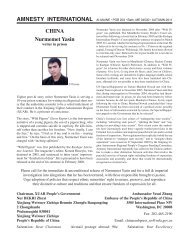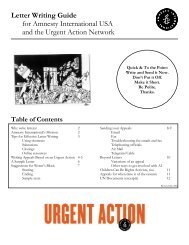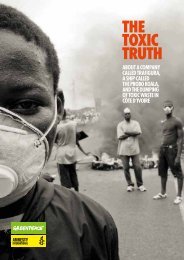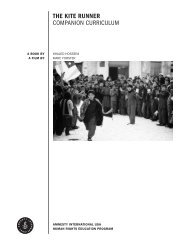Blood Diamond Curriculum Guide (PDF) - Amnesty International USA
Blood Diamond Curriculum Guide (PDF) - Amnesty International USA
Blood Diamond Curriculum Guide (PDF) - Amnesty International USA
You also want an ePaper? Increase the reach of your titles
YUMPU automatically turns print PDFs into web optimized ePapers that Google loves.
LESSON 3 CORPORATE SOCIAL RESPONSIBILITY<br />
4. After the groups have had time to discuss the questions, ask a representative from each<br />
group for the group’s definition of CSR. As a class, list the responsibilities that corporations<br />
should have and ask why the corporation should be held responsible in each situation.<br />
Discuss the groups’ answers to the other discussion questions.<br />
5. Distribute “Conflict <strong>Diamond</strong>s: Cote D’Ivoire.” Either individually or in groups, the students<br />
will read the case study. The students will then use the discussion questions at the end of the<br />
case study to begin a conversation about the connection between the diamond industry,<br />
regional conflicts, and human rights abuses. Use the resource guide at the end of this lesson<br />
to find additional materials, including maps and reports, relating to Cote d’Ivoire.<br />
6. A wealth of organizations and international bodies have attempted to define, regulate, and<br />
enforce CSR policies. Most organizations currently rely on a voluntary reporting and<br />
monitoring system. For example, the United Nations developed the Global Compact, a set of<br />
ten basic principles modeled on international documents to which companies have voluntarily<br />
agreed to abide. The UN Human Rights Norms for Business, approved by a UN<br />
subcommission in 2003, explains the human rights obligations of companies, highlighting best<br />
practices and various modes of monitoring and enforcement. The Norms provide a standard<br />
for companies to measure themselves against, a benchmark against which national legislation<br />
can be judged, and a framework for advocacy groups. Other international initiatives include<br />
the Global Reporting Initiative (GRI) and the <strong>International</strong> Labour Organization’s Core Labour<br />
Standards (ILO).<br />
Distribute the UN Human Rights Norms for Business. Ask students to read the Norms for<br />
Business, and brainstorm ideas for ways that companies and governments could implement<br />
the standards it promotes.<br />
7. Distribute Handout 3.2: Understanding the Kimberley Process. Ask students to read the<br />
report individually, and write down any questions they have about the Kimberley Process.<br />
Discuss the ways that international and national laws affect the actions of corporations, and<br />
answer student questions about the Kimberley Process. How could governments, NGOs, and<br />
consumers work together with companies to ensure the effectiveness of the Kimberley<br />
Process?<br />
8. As a class, brainstorm ways that consumers can impact the actions of companies. Ask<br />
students to think of specific examples and ideas. Leave the students with the following<br />
questions:<br />
• How can you as a consumer or activist affect the actions and decisions of a large<br />
multinational corporation?<br />
• What actions can you take to encourage businesses to adopt policies that promote<br />
human rights and the triple bottom line?<br />
38






